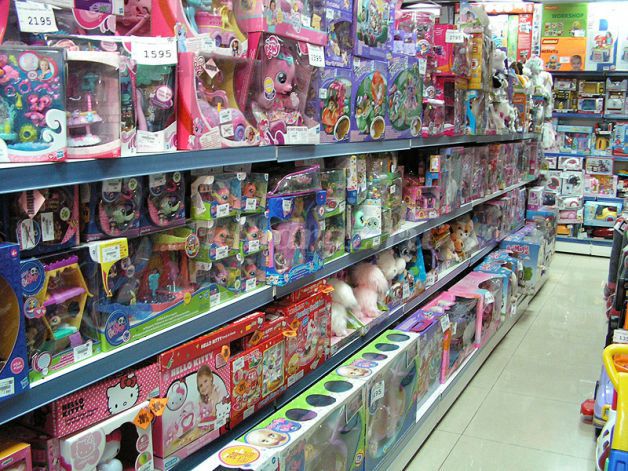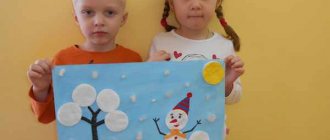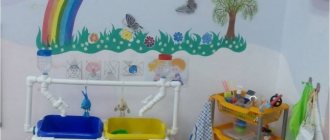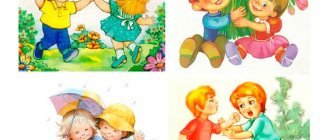Lesson summary "Toys" in the middle group
Summary of a lesson on speech development on the topic “Toys” in the middle group
Direct educational activities in the middle group
Topic: Toys.
Target:
practicing the ability to form adjectives; correlate nouns with adjectives in gender, number, case; Expansion and systematization of vocabulary; Dictionary: rubber, iron, glass, cardboard, plastic; Cultivate a caring, friendly attitude towards toys; teach children to put their toys away after themselves.
Equipment
: pictures of toys; a wonderful bag of toys; Mashenka doll; toys: bunny, spinning top, boat, kite, lantern, Teddy bear with a bow (for beauty).
Progress of direct educational activities
1. Organizational moment
(task for children).
Cutting pictures - make a picture from parts and name it. - Guys, what do you think we will talk about today? About toys. All toys are made from different materials. And today we will talk about what toys are made of and what they are like. 2. Studying new material.
Game: Wonderful bag.
Children take out toys by touch and name them; then determine the material from which they are made. - What did you get? - ball. -What is it made of? - made of rubber. - So what kind of ball is it? - rubber ball. Questions clarify the answers: rubber ball; glass ball; wooden cube; iron soldier; plastic scoop; cardboard fish. It is important to ensure that children give complete answers. Game: Let's help the doll Mashenka.
A sad doll Mashenka appears - Why is Mashenka so gloomy, so sad?
All her toys have run away because she doesn't know what they are made of. Let's help Mashenka. We need to find toys and name what they are made of and what they are. Children find toys in the play corner and return to the teacher. You need to name the toy and say what it is. (I have a fur hare; an iron spinning top; a blue ship; a beautiful Bear; a big snake). - Mashenka, do you remember? Tell me what the toys are made of? - Children, did Mashenka answer correctly? - Why isn’t it right? — She didn’t name the material, didn’t say what the toys were made of. - Let's remember once again what kind of toys Mashenka has and what they are made of. Children answer using relative adjectives. 3. Physical education minute.
- Guys, you have all been turned on with a key, you are wind-up dolls (the children walk around pretending to be wind-up dolls).
And now you are bunnies (children jump, imitating bunnies). And now you are bears (imitation). And now the foxes (imitation). And now all the balls are big and small; boys are big and girls are small balls; and they jump in different ways: big ones - high, small ones - lower (then they changed: the girls became big balls, and the boys - small ones). 4. Fixing the material.
Game: Toy Store.
Children look at toys on the shelf. Play activities: children go out and buy the toy they like. Condition: buy only toys made from the same material. First, they buy wooden toys. You need to name it, say what it is, what the toy is made of. — I bought a wooden spoon. I bought a wooden nesting doll. I bought a wooden horse. I bought a wooden cube. — The wooden toys are all gone, they’re all sold out. And now they sell rubber toys. Then plastic toys go on sale. Then iron ones. The teacher asks the children to help, clean up the store and place the toys on the shelves; the children arrange the toys, classifying them. - Well done, guys, you behaved well in the toy store today, played carefully with them, carefully placed the toys on the shelves. Reflection: Children, did you like the toy store? What toys were the most fun to play with? 5. Summary.
Closing conversation. — Guys, what other toys and what materials do you know? Yes, guys, today you learned a lot of interesting things about toys, you played happily and amicably with different toys. The teacher praises the children for their attentiveness and complete answers.
OOD summary on the topic: “Every toy has its place”
Subject:
“Every toy has its place”
Target:
Strengthen the ability to put toys away.
Tasks:
Educational:
— Strengthen the ability to distribute toys in their places;
— Improve children’s ability to participate in carrying out collective work assignments;
- Learn independently, highlight the disorder in the environment;
Educational:
— Develop a desire for everyday work, careful attitude towards toys;
-Develop accuracy, attention, imagination, creativity;
Educational:
— Foster humane feelings and positive relationships between children;
— Cultivate the desire to work for the common good, to understand the significance of one’s work for others.
Materials:
toys: cars, dolls, dishes, cubes, pyramid; pencils; coloring books; paper; emblems on the baby's chest.
Vocabulary work
: nouns: car, doll, pyramid, cubes, cleaning, help, play area, corner, group room.
Verbs: help, help out, interact, work.
Adjectives: neat, polite, rude, bookish, artistic.
Preliminary work:
reading fiction: K.I. Chukovsky “Moidodyr”, “Fedorino’s Mountain”; memorizing Ouspensky’s poem “Everything is Alright”; conversation about work;
Methods and techniques:
gaming – didactic game; visual - looking at the playroom; practical – children’s independent activities; verbal – teacher’s story, questions.
Progress of direct educational activities.
Conversation about work.
(Children enter the group and sit on chairs)
- Guys, look what happened in the group? (Children's answers).
— Maybe someone in our group played? What changes do you see? Do you put away toys? Why do you need to put away toys? (Children's answers)
- Guys, look, what happened in our group?
- Now let's watch the scene.
Dramatization of Ouspensky's poem "Everything is Alright"
(Guys, show a scene from a poem)
Mom comes home from work, Mom takes off her boots, Mom goes into the house, Mom looks around. — Was there a raid on the apartment? - No. — Did a hippopotamus come to see us? - No. - Maybe the house is not ours? - Our. - Maybe not our floor? - Our. Seryozhka just came and we played a little. - So this is not a collapse? - No. — Didn’t the elephant dance with us? - No. - I am very happy. It turned out that I was worried in vain!
Practical activities. Cleaning toys.
- So who scattered the toys in our absence? (Children's answers)
— Why is it difficult to find a toy? (Children's answers)
- What toys are located in which play corner? What should be in the art corner? (Children's answers)
Project on the theme of the week “World of Fashion” in the middle group
Taimyr municipal budgetary preschool educational institution "Dudinsky Child Development Center - Kindergarten "Snow White", Dudinka city
Project on the theme of the week “World of Fashion”
In the middle group "Daisies"
Educator:
Kovalchuk N.V.
Objective of the project:
Expand and concretize children’s ideas about clothing
,
its purpose, and the details of which it consists.
Project objectives:
To form children’s ideas about clothing, its types, parts of clothing.
Develop children's speech and expand their vocabulary.
Develop color perception, figurative ideas, creativity, imagination, compositional skills, color perception.
Teach children to generalize, classify, systematize.
Teach children to take care of their clothes and develop a caring attitude towards them.
Project type:
group
Project type:
Creative, short-term, collective.
Duration:
short-term, 1 week (09.11-13.11)
Project participants:
children of the secondary group "Romashki", teachers, parents
Final event:
Role-playing game "Clothing Store"
Working with parents:
moving folders, information stand, three question method.
Project implementation stages:
Stage 1.
Selecting a project topic.
Thematic plan for the 2019-2020 academic year.
Selection of methodological literature on the topic of the week.
Selection of material, games - experiments, didactic games.
| Creativity Center Plasticine, crayons, paints, foam rubber, sticks, pictures, stencils, glue, templates, scraps of fabric | Book Center books by B. Grimm, N. Nosov. pictures on the topic of the week. | Experimentation Center Waste material, watering can, containers of various sizes, cups, molds, scraps of various fabrics |
| Construction Center constructor, cubes, mosaic, lego | Subject: "Fashion world" | Game center Attributes for s.zhetno role. games “Clothing Store”, “Family” |
| Cognition Center (board, exhibition) pictures on the theme of the week, fabric scraps | Theater Center Bibabo, house, finger. Theater, screen. | Center of movement Sport. equipment, massage mats, modules, engines, ribbons, flags, steering wheels. |
- by type of children's activity:
| Gaming We play board and printed games “Find a pair”, “Dress the doll”, “Find an object”, “Who is wearing what” puzzles, plot-role-playing games using attributes, | Artistic Reading fairy tales and stories by B. Grimm, N. Nosov | Communicative speech games, looking at pictures |
| Motor Fun games, p/i, games to develop dexterity, eye | Subject: "Fashion world" | Labor We clean the corner of nature, the group, wash the toys, water the flowers, put the toys in their places. |
| Cognitive and research We look at pictures and experiments with fabrics | Productive sculpt, draw, design | Musical Imitation of various sounds, playing musical instruments |
Summary of GCD for children in the middle group. History of children's toys
Summary of the direct educational activities of children in the middle group
Abstract of children's educational activities in the middle group "History of children's toys"
Description of the material: Dear colleagues! I bring to your attention a summary of direct educational activities for children of the middle group (4-5 years old) on the topic “History of children's toys.” This summary will be useful to teachers of the middle group. This is a summary of an educational lesson aimed at fostering interest in the history of toys and respect for Russian traditions and customs. Integration of educational areas: social-communicative, cognitive, speech, artistic-aesthetic, physical development. Type of activity: visual, motor, cognitive-research, gaming, communicative. Age group: middle Topic: “History of children's toys” Purpose: introducing children to the history of toys Objectives: - development of communication and interaction of the child with adults and peers, formation of positive attitudes towards various types of work and creativity (social and communicative); — development of children’s interests, their curiosity and cognitive motivation; development of imagination and creative activity (cognitive); — enrichment of the active dictionary; development of coherent, grammatically correct dialogical and monologue speech (speech); — implementation of independent creative activity of children; the formation of an aesthetic attitude towards the surrounding world (artistic and aesthetic); - mastering outdoor games with rules; formation of focus and self-regulation in the motor sphere (physical). Preliminary work: 1. Joint visit to the Puppet Theater with parents; 2. Exhibition “Do-it-yourself toys”; 3. Repetition of previously learned poems by A. Borto from the “Toys” series; 4. Examination of plot pictures and composing a story based on them; 5. Watching the cartoon “Living Toy”; 6. Conversation about favorite toys; 7. Learning physical education Means of implementation: photo and video materials with toys from different eras; audio recordings from children's cartoons about toys; individual modeling kits (board, stack, plasticine, napkin); Gena's bi-ba-bo crocodile toy; children's favorite toys. GCD procedure: Children sit on soft cushions on the floor in a semicircle. To the music “Let them run clumsily...” from the cartoon “Cheburashka and the Crocodile Gena,” the teacher brings in the bi-ba-bo toy “Crocodile Gena” with a bag and conducts a dialogue with the children on behalf of the toy. He greets the children and pays attention to how many toys there are in the kindergarten. Addressing the children, he asks them to name and show them their favorite toy, describe it and tell them why he likes it. Listens carefully to the children's answers and invites them to listen to a story about the toys of their childhood. He takes out photographs of toys from those years from his bag, shows them and tells the children about them. He clarifies that previously toys in stores were very expensive and not everyone could afford them, so parents made toys for their children themselves. They were made of wood, straw, cloth, animal bone, feathers, clay, etc. This material is environmentally friendly and does not cause harm to health.
The teacher invites Gene and the children to watch a video using multimedia, which shows the manufacturing process and a story about the first straw toy “Bereginya”. He clarifies that this toy was not only an object of play for the child, but was also his amulet, protecting him from evil spirits.

Next, the teacher suggests comparing modern toys with toys of those years. Find similarities and differences in material, colors, sizes, properties, etc. It should be noted that modern toys have more capabilities: they move, make sounds, react to the approach of a child, etc.

We recommend watching:
Synopsis of an integrated GCD in kindergarten in the middle group Synopsis of GCD in the middle group on the theme “New Year” Synopsis of a lesson on applications in the middle group of kindergarten. Flowers Summary of GCD for FEMP in the middle group
Similar articles:
Lesson in the middle group “Winter clothes”


